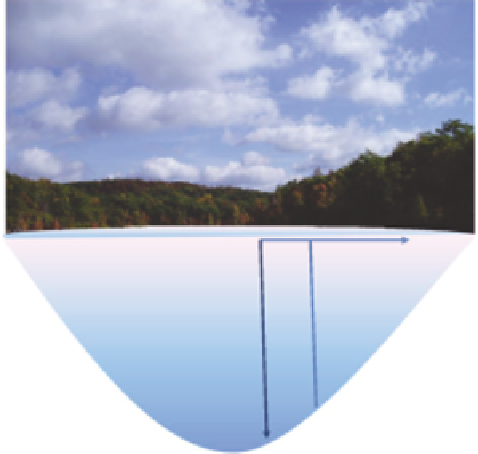Environmental Engineering Reference
In-Depth Information
or
thermocline
, the maximum vertical temperature gradients occur. The thermocline is commonly
deined where a minimum of a 1°C temperature change per meter of depth occurs.
The depth of the thermocline at any time is controlled by the seasonal climate, the occurrence
of storms, water temperature, water depth, lake bathymetry, the strength of inlow and outlow cur-
rents, and other factors covered in more detail by Hutchinson (1957), Wetzel (2001), Chapra (2008),
and Ford and Johnson (1981).
In the fall, changes in the surface heat budget (a reduction in solar heating and air temperatures,
etc.) result in cooling of the surface waters. As the epilimnion cools, the density gradient lessens
and wind mixing penetrates further down the water column. Also, as the surface water cools and
becomes denser than the waters immediately beneath it, the water sinks causing convective mixing.
The thermocline erodes and becomes deeper and ultimately the entire lake mixes (Figure 12.14).
This is referred to as the fall overturn. Following overturn, the entire lake or reservoir may continue
to cool.
As cooling continues during the winter months, the water temperature may approach 4°C and
then cool beyond that temperature. As the temperature of the surface water drops to less than 4°C
and becomes less dense, inverse stratiication occurs. In inverse stratiication, the temperature of
the surface water is colder but less dense than the waters below it, which remain at 4°C on the bot-
tom of the lake. Ice cover can contribute further once the lake freezes. The ice cover prevents wind
mixing and erosion of the density differences. The surface layers next to the ice remain near 0°C
to maximize the mild inverse density difference. Inverse stratiication is so mild that often a dis-
tinct thermocline does not form and the epilimnion and hypolimnion are not well deined. Inverse
stratiication persists until spring warming heats the surface layer. As the temperature of the surface
layer approaches the temperature of the hypolimnion, which is usually 4°C, spring overturn occurs.
Then, with springtime solar heating, the stratiication cycle is started anew (Figure 12.15).
Some lakes and reservoirs, especially run-of-the-river reservoirs, do not follow the general strati-
ication pattern. Shallow lakes and reservoirs only weakly stratify due to relatively high lows or the
dominance of wind mixing. The thermocline may be dificult to deine. Complete mixing may occur
during the summer stratiication period as a result of wind or runoff events. Fall overturn occurs earlier
in shallow lakes than in deeper lakes. In warmer climates, such as much of the Southern United States,
Temperature
FIGURE 12.14
Period of complete mixing (e.g., spring and fall).

Search WWH ::

Custom Search